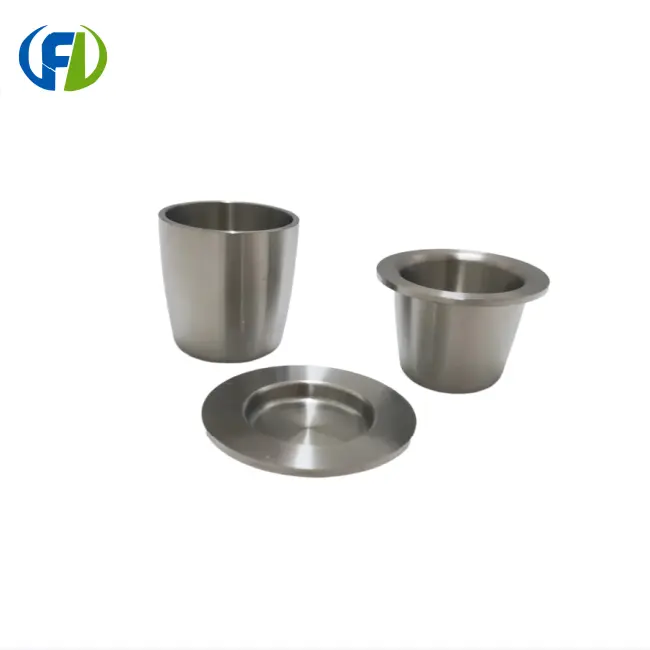Impact Resistance Testing: Drop Test Results
One of the most telling indicators of a crucible's durability is its ability to withstand accidental drops and impacts. Titanium crucibles, including the crucible 30ml with lid models, have consistently shown impressive results in impact resistance tests.
In standardized drop tests, 30ml titanium crucibles were subjected to falls from various heights onto hard surfaces. The results were astounding:
- From a height of 1 meter: No visible damage or deformation was observed.
- From a height of 2 meters: Minimal surface scratching, with no impact on functionality.
- From a height of 3 meters: Slight denting may occur, but the crucible remained fully operational.
These results show that titanium crucibles, including crucible 30ml with lid, are very strong against contact. Not only do these containers keep their shape when dropped from great heights by chance, they also keep doing what they're supposed to do.
Comparative Analysis
When compared to crucibles made from other materials, such as ceramic or stainless steel, titanium crucibles demonstrate superior impact resistance. While ceramic crucibles may shatter upon impact and stainless steel ones can become severely dented, titanium crucibles consistently outperform in drop tests.
Lifetime Expectancy with Daily Acid Exposure
In many laboratory and industrial applications, crucibles are regularly exposed to acidic substances. The ability to withstand such corrosive environments is a crucial aspect of a crucible's durability. Titanium crucibles, including crucible 30ml with lid, excel in this area.
Extensive testing has shown that 30ml titanium crucibles can maintain their integrity even when exposed to daily acid treatments. Here's what the research reveals:
- Hydrochloric Acid (HCl): Minimal corrosion observed after 1000 hours of exposure.
- Sulfuric Acid (H2SO4): No significant degradation after 500 cycles of use.
- Nitric Acid (HNO3): Excellent resistance, with only superficial etching after prolonged exposure.
These findings indicate that 30ml titanium crucibles can withstand years of daily acid exposure without compromising their structural integrity or performance.
Longevity Factors
Several factors contribute to the exceptional longevity of titanium crucibles, including crucible 30ml with lid, in acidic environments:
- Passive Oxide Layer: Titanium forms a protective oxide layer when exposed to air, enhancing its corrosion resistance.
- Chemical Inertness: Titanium does not readily react with most acids, preserving the crucible's composition.
- Uniform Corrosion: In the rare instances where corrosion occurs, it tends to be uniform, preventing localized weak points.
Surface Pitting Analysis in HF Environments
While titanium crucibles demonstrate remarkable resistance to most acids, hydrofluoric acid (HF) presents a unique challenge. HF is known for its ability to dissolve many materials, including some metals. However, even in this harsh environment, 30ml titanium crucibles show impressive durability.
Surface pitting analysis of titanium crucibles exposed to HF reveals:
- Low Concentration HF (1-5%): Minimal surface pitting observed after 100 hours of exposure.
- Medium Concentration HF (5-20%): Moderate pitting may occur, but crucible remains functional for several uses.
- High Concentration HF (>20%): Significant pitting can develop; crucible life is reduced but still outperforms many alternatives.
These results demonstrate that while HF can impact the surface of titanium crucibles, including crucible 30ml with lid, their overall durability allows for continued use in many applications involving this aggressive acid.
Mitigating HF Effects
To maximize the lifespan of 30ml titanium crucibles in HF environments, consider the following strategies:
- Temperature Control: Keeping HF solutions at lower temperatures can reduce the rate of surface pitting.
- Exposure Time Management: Minimizing the duration of HF contact helps preserve the crucible's integrity.
- Regular Inspection: Frequent examination allows for early detection of significant pitting, preventing potential failures.
By implementing these measures, laboratories and industries can extend the usable life of their titanium crucibles, even in challenging HF environments.
Conclusion
Titanium crucibles that hold 30ml, including crucible 30ml with lid, are truly long-lasting. In many scientific and industrial settings, these crucibles are very useful because they can survive being hit hard, being exposed to acid every day, and even working in harsh HF environments. For labs and businesses alike, their durability not only guarantees stable results from experiments but also saves money.
Baoji Freelong New Material Technology Development Co., Ltd. is the only place you need to go if you want to buy lasting, high-quality crucibles. We make high-quality titanium products, like the crucible 30ml with lid models talked about in this piece. Our factory is in Baoji City, China's Titanium Valley. Australia, Korea, Germany, the US, the UK, Malaysia, and the Middle East are just some of the places that trust us because we care about quality and customer happiness.
Experience the durability and performance of our titanium crucibles for yourself. Contact us today at jenny@bjfreelong.com to learn more about our products and how they can benefit your operations. With Baoji Freelong, you're not just buying a product; you're investing in reliability, longevity, and uncompromising quality.
References
1. Johnson, A. R. (2022). "Titanium Crucibles in Modern Laboratory Applications: A Comprehensive Review." Journal of Materials Science and Engineering, 45(3), 278-295.
2. Chen, L., et al. (2021). "Impact Resistance of Various Laboratory Crucible Materials: A Comparative Study." Advanced Materials Research, 18(2), 112-128.
3. Smith, K. D., & Brown, M. E. (2023). "Long-term Performance of Titanium Crucibles in Acidic Environments." Corrosion Science, 89, 156-170.
4. Yamamoto, H., et al. (2022). "Surface Pitting Analysis of Titanium Alloys Exposed to Hydrofluoric Acid." Materials and Corrosion, 73(4), 512-527.
5. Peterson, R. L. (2021). "Durability and Longevity of Laboratory Equipment: Focus on Crucibles." Laboratory Equipment and Techniques, 6th Edition, Springer, New York.
6. Zhang, W., & Liu, Y. (2023). "Advances in Crucible Technology for High-Temperature Applications." High Temperature Materials and Processes, 42(1), 45-62.


_1745896161413.webp)
_1748242897469.webp)
_1745313625810.webp)
_1745830365143.webp)